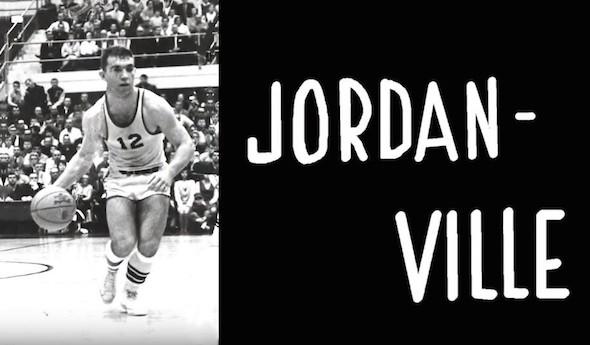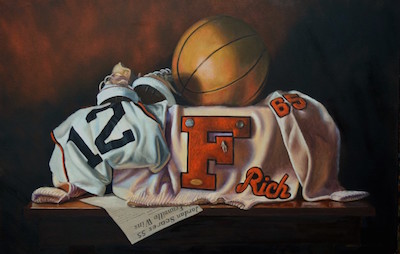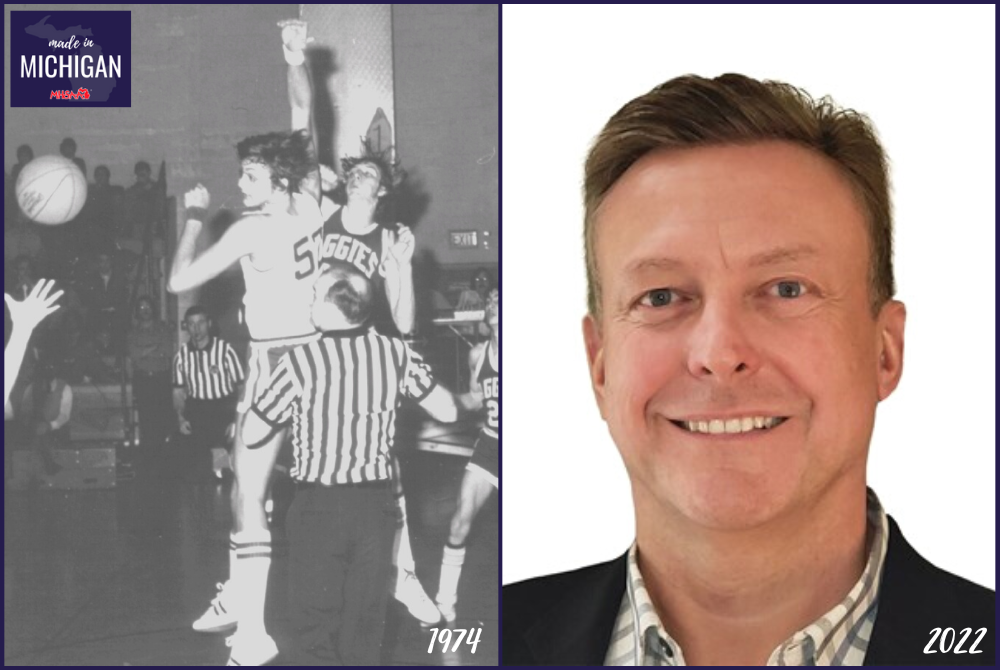
Film Fills In Picture of 'Fennville Flash'
By
Ron Pesch
MHSAA historian
December 28, 2017
We’ve been here before, but not in this way.
The last time was for a retrospective, covering one of the most impressive and awe-inspiring prep careers in Michigan high school history. That time was in print, and included a handful of still images that tried to illustrate the unbelievable.
But this time, the story is in documentary form. It’s woven together from grainy, scratched, faded silent film, a format of capturing memories familiar to thousands of people from generations past, as well as a series of modern-day high-resolution interviews.
Here, the basketball life of the athlete known as the “Fennville Flash” delivers on many levels. Yes, there is a Richie Jordan.
JordanVille, a documentary by John Mooy & Anne Colton, recalls a time when legend spread via word of mouth, newsprint and AM radio.
While it’s hard to comprehend for many today, the exploits of our athletic heroes were formed by “poets in the press box” who sat with pencil and paper, a typewriter, a microphone or a telephone, and described to their audience what they witnessed. On the receiving end, readers and listeners conjured up visualizations based on the facts, phrases and superlatives designed to create an image.
“Traveling left to right on your radio dial” helped listeners feel they were a member of the crowd, seated in the stands, in on the action and a witness to the mayhem. “Packed to the rafters,” reminded fans the importance of what was happening. An exciting game, presented by those with skill, created an event you longed to see. If a broadcast couldn’t be picked up on a transistor or tube radio, the final result might not be known, at the earliest, until the following day’s newspaper arrived.
I’ve told Jordan’s story via the MHSAA before; how he latched on to athletic training, weights and repetition to mold himself into a well-rounded athlete, able to leap to heights unexpected for a kid with a 5-foot-7 frame. The tales of his unfathomable accomplishments slowly leaked beyond the city limits of Fennville into Kalamazoo and greater Southwestern Michigan, then to Detroit. When Detroit Free Press writer Hal Schram relayed Jordan’s feats, the secret traveled across the state and beyond its drawn borders.
From there the legend of Jordan’s accomplishments grew. In Fennville, as in many small towns across the country, the city shut down when a game was played. The Jordan story was so enticing that thousands would travel vast distances to see him play with their own eyes. Today, his single season scoring average of 44.4 points per game during the 1964-65 campaign still remains the top mark in the MHSAA record book.
 JordanVille runs just shy of a half hour. Contained within is insight into the athlete that is challenging to relay in print form. Thanks to access to home movies and a series of interviews with Jordan, former teammates, past opponents and his high school coach, the determination, dedication and drive of a kid who wouldn’t let physical size be a deterrent from achievement radiates from the screen. On display is small town America at its finest, and perspective formed over 50+ years.
JordanVille runs just shy of a half hour. Contained within is insight into the athlete that is challenging to relay in print form. Thanks to access to home movies and a series of interviews with Jordan, former teammates, past opponents and his high school coach, the determination, dedication and drive of a kid who wouldn’t let physical size be a deterrent from achievement radiates from the screen. On display is small town America at its finest, and perspective formed over 50+ years.
For Mooy, it completes a filmmaking journey started six years ago. But the story of Jordan, in his eyes, date back to his school days. Mooy first heard about Jordan as a 7th-grader from a math teacher. A second-team all-St. Joseph Valley League selection, Mooy played at Marcellus High School and scrimmaged against Jordan and the Fennville Blackhawks.
He couldn’t believe his eyes.
“Everyone wanted to see this kid play,” said Mooy in 2011. “He was the first high school player I saw sign an autograph.
Today, with the interviews complete, and the film ready for viewing, Mooy sees more than just a sports story:
“With the benefit of years now passed, I look at the Rich Jordan story with a new respect. JordanVille created a place that was welcoming no matter who you were, or what color your skin happened to be. It was the 1960s. Rich was growing up Jewish, the Civil Rights Movement was in full swing, and the Vietnam War was on everyone's mind. And in Fennville, Michigan, from 1961 to 1965, the Jordan high school years, there were lessons beyond sports being learned by everyone that would last a lifetime. The Jordan household, under the guidance of (his parents) Tuffy and Sylvia Jordan, is where the story begins."
The film speaks of a time that has departed. Competition for our attention was less focused; phones hung on walls or sat on tabletops, communities were tighter, the training table featured peanut butter and chocolate milk instead of protein powder. A city could easily be renamed for a day.
The film also reminds us that those days were far from perfect.
If all goes as planned, the public will see the finished product come the flip of the calendar. In West Michigan, JordanVille is scheduled to show on New Year’s Day at 6 p.m. on WGVU, and will repeat on WGVU-Life at 7:30 p.m., Friday, Jan. 5.
Seek it out, and spread the word, just like in days of old.
 Ron Pesch has taken an active role in researching the history of MHSAA events since 1985 and began writing for MHSAA Finals programs in 1986, adding additional features and "flashbacks" in 1992. He inherited the title of MHSAA historian from the late Dick Kishpaugh following the 1993-94 school year, and resides in Muskegon. Contact him at [email protected] with ideas for historical articles.
Ron Pesch has taken an active role in researching the history of MHSAA events since 1985 and began writing for MHSAA Finals programs in 1986, adding additional features and "flashbacks" in 1992. He inherited the title of MHSAA historian from the late Dick Kishpaugh following the 1993-94 school year, and resides in Muskegon. Contact him at [email protected] with ideas for historical articles.
PHOTOS: (Top) Richie Jordan runs Fennville's offense during his thrilling high school career in the 1960s. (Middle) Jordan memorabilia, as captured by Bill Williams.

Championship Memories Still Resonate with St. Thomas Star Lillard
By
Doug Donnelly
Special for MHSAA.com
July 21, 2022
It took about four decades, but a couple of years ago, Len Lillard finally got to watch the 1974 Class D Boys Basketball Final.
The outcome, of course, was the same as when Lillard, a star 6-foot-7 center from Ann Arbor St. Thomas, dominated the game and led the Irish to the championship that March. But it was just as fun to watch it once more.
“It was great fun to watch,” Lillard said. “It was interesting, to say the least.”
Lillard had a sensational athletic career at St. Thomas, now known as Father Gabriel Richard. Not only was he an outstanding basketball player, but he also won Lower Peninsula Class D Finals high jump and shot put championships.
He earned a scholarship to the University of Michigan and played four years for the Wolverines, including the season they made it to the Final Four and faced undefeated and eventual national champion Indiana.
“Their top seven guys played professionally,” Lillard recalled. “That team was outstanding.”
Today, 50 years later, Lillard is a successful investment banker living just outside of Chicago. He hasn’t lived in Michigan since 1987, but still has close ties to teammates from the University of Michigan – and St. Thomas. He plans this month, in fact, to attend a Michigan basketball alumni function in Ann Arbor.
“We stay in touch,” he said.
Lillard said playing for the Michigan Wolverines opened a lot of doors for him professionally.
“It was a very good ice-breaker,” he said. “In the financial world I was in, you had to talk to people about tens of millions, sometimes hundreds of millions of dollars in investments. You have to prove yourself and be competent very quickly. But, the basketball, the Final Four … it was a good conversation starter.”
Lillard was part of an outstanding group of athletes that happened to attend St. Thomas during the same time frame.
“I think it was a case of the stars lining up,” Lillard said. “It was just a couple of really good classes that happened to be at the same school at the same time.”
St. Thomas moved from the Catholic High School League to the Tri-County Conference when Lillard was a senior. The TCC was a new conference and, ultimately, offered little competition for the Irish in almost any sport.
St. Thomas was heads and shoulders better than the rest of the league and easily went 10-0 to claim the first boys basketball league title under coach Mike Ramker. Lillard averaged 23.6 points a game in league play. In one of the most dominating performances in league history, Lillard scored 42 points and pulled down 31 rebounds in a win over Whitmore Lake.
In the Class D Semifinals he scored 31 points and had 13 rebounds. In the 68-53 win over Harbor Springs to clinch the title, Lillard scored 18 points and added 18 rebounds and six blocked shots.
Word around the MHSAA Tournament was Lillard was headed to Notre Dame. Instead, he accepted a scholarship from Michigan, which was located just a couple miles from the gym where St. Thomas played.
“He was a tremendous athlete for his time,” Ramker said.
Lillard was a member of the 1975-76 University of Michigan men’s basketball team that played in the Final Four and was defeated in the national championship game by the undefeated Indiana Hoosiers.
“It was a great experience,” said Lillard. “Our basketball fans, and some football fans as well, were very excited and a lot of them made the trip to Philadelphia, so we had a loud cheering section.”
The Final Four was a bit different during that era, but it still was a big deal.
“This was pre-ESPN, so there was not hourly coverage, but even though players and coaches try to be low key, it was a big deal to make it to the finals,” Lillard said.
Lillard could have gone to a smaller school and received more playing time, or perhaps another Big Ten school. Getting an education from the University of Michigan, however, was worth it. Lillard said making the transition from Class D to Division I college basketball wasn’t easy.
“It was difficult. I knew the competition would be much harder which it was, but there were other issues that I was not as prepared for,” he said. “At the end of the day, I was not going to play professional basketball, and playing for a highly-ranked University of Michigan team and earning a degree from Michigan was a great accomplishment.”
Lillard appeared in five games in 1975-76. He came back to the Wolverines in 1976-77 and appeared in 11 games, making 8 of his 12 field goal attempts, both of his free throws and pulling down 14 rebounds. Coached by Johnny Orr, the Wolverines were ranked No. 1 in the country, won the Big Ten championship and advanced to the Elite 8.
Lillard graduated from Michigan in 1978 and joined his family’s contracting business. At the same time, he started night school in pursuit of a Master of Business Administration degree. He got married and moved away from the Ann Arbor area.
He has more than 30 years of experience working in finance and capital markets as part of such well-respected firms as Merit Capital Partners, Banc One Capital Partners and The Prudential Capital Group. Today, at 66, he is managing partner with Glaucon Capital Partners.
He and his wife Karen raised three sons, now aged 29, 26 and 24. The middle child, Grant, was Big Ten Freshman of the Year and Defensive Player of the Year while playing soccer at the University of Indiana. He now plays professionally in Major League Soccer.
“He was a much better athlete than me,” Lillard said.
Basketball and sports in Michigan are never too far from Lillard’s mind. He checks in with old teammates on occasion and once had coffee with an opponent who he battled in the Final from Harbor Springs who was a sheriff in a town where he vacationed.
“He was a great guy,” Lillard said. “We had a lot of fun with it.”
It was a former St. Thomas teammate who rediscovered the film of the championship game. He had the film converted to a DVD and gave copies to team members. Those Finals were played at Jenison Field House at Michigan State University – one of several interesting places St. Thomas played at during Lillard’s career.
“Some of my fondest memories are playing in some of the old Catholic League gymnasiums,” Lillard said. “Some of the second-floor gyms with a running track around them were so amazing, such tiny little gyms. Some of them had clocks that still wound. You never really knew how much time was left in the quarter. We had some great times, that’s for sure.”
2021-22 Made in Michigan
July 14: Portage Central Champ Rolls to Vanderbilt, Writing Next Chapter in Alabama - Read
July 12: Coaching Couple Passing On Knowledge, Providing Opportunities for Frankfort Wrestlers - Read
June 30: Hrynewich's Star Continuing to Rise with Olympic, Pro Sports Arrivals - Read
PHOTOS (Top) At left, Len Lillard as the standout on the Ann Arbor St. Thomas boys basketball team in 1974; at right, Lillard today as a father of three and successful investment banker. (Action photo courtesy of Doug Donnelly, current photo courtesy of Glaucon Capital Partners).

